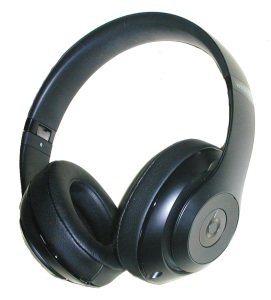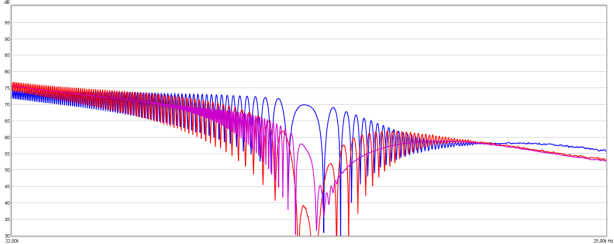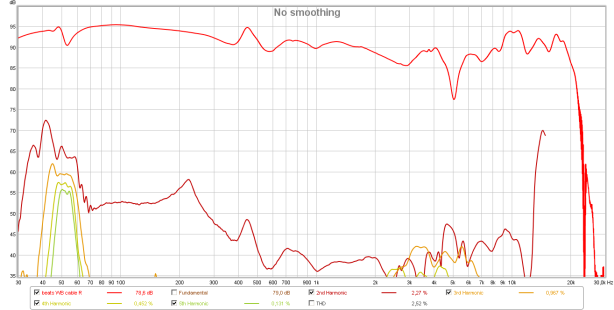Beats
published: Jan-24-2016, updated Jul-11-2021
NO SMOOTHING is applied to the shown plots. Most measurement sites have some smoothing applied which ‘irons flat’ sharp peaks and ‘wiggles’. I do not use smoothing because some info about sound quality is lost when plots are smoothed.
Aside from a small correction of the microphone itself also some correction in the lowest frequencies is applied to the plots to compensate for the perceived loss of bass when using headphones. This is described HERE in more detail.
A ‘horizontal‘ frequency response curve on the shown frequency response plots on this website thus indicates a perceived ‘flat’ tonal signature.
ALL measurements are made with a good SEAL on a flatbed measurement rig.
The shape of your head, bone structure, pad size, pad ‘softness, (compliance), hair or no hair and or wearing glasses may (drastically) change the frequency response of some headphones, so… your personal experience may differ substantially from these plots.
Frequency response (tonal balance) is the most sound-determining aspect of headphones. A horizontal line shows audible neutral response in the plots on this website. Deviations in different severities at different frequency bands have an effect on the sound character.
The bigger the deviation the stronger the effect.
Below an aid to help determining the sound character of headphones with relation to the frequency response.

Beats studio Wireless
(bluetooth & noise cancelling)

This is the Beats studio version. It has 2 features you don’t see on most headphones.
It has a wireless bluetooth connection as well as Noise Cancelling.
Because wireless becomes more ‘important’ and convenient every day, more and more bluetooth headphones are being marketted.
There are less Noise Cancelling headphones around than there are with bluetooth in it.
Noise Cancelling usually comes with the downside of low level hiss which can be audible in quiet passages.
Some background info about Noise Canceling is found in the measurements of the Bose QC25.
The Noise Cancelling part can NOT be switched off so an audible but not ‘sharp’ noise will always be heard in quiet passages.
Another downside is … the battery needs to be full.
Empty battery = no music even when the music source still plays on.
Fortunately all it takes is a micro USB cable to charge it. Everyone taking their tablet or phone along on a trip is most likely to pack a charger as well having the same micro-USB plug.
The Beats Studio Wireless has both features. There are many more headphones around that combine these features ranging in price from €100 to €500 for the most common brands.
Sony MDR-ZX550BN €90
Philips SHB8850NC €120
JAM Transit City €130
Sony MDR-ZX770BN €160
Plantronics Backbeat Pro €200
Sony MDR-ZX770BN €240
Sony MDR-ZX750BN €250
Samsung level On wireless €250
Sennheiser MM 450-X €260
Sennheiser MM 550-X Travel €280
JBL Everest Elite 700NC €280
Sennheiser Momentum 2.0 On-ear Wireless €350
Beats Studio Wireless €350
Sennheiser Momentum 2.0 Wireless €450
Bang & Olufsen BeoPlay H8 €480
Then there is also a plethora of cheap headphones around with the same funcionality.
The Beats Studio Wireless is one of the most expensive ones.
Beats isn’t very popular in the more audiophile circles and there is a general detest for its sound and marketting BS.
The measurements made here are all done using a wired connection (3.5mm TRS jack cable is provided) as this is likely to give the best results.
specifications:
Type: Over ear, closed, wireless, Noise Cancelling
Usage: Home, studio, portable
Driver type: dynamic
Pads: replaceable, pleather
Collapsible: Yes
Colour: Various options
Headphone cup connector: 3.5mm TRS jack
Cable entry: single sided, left cup
Cable: 1.4m terminated in a 3.5mm TRS jack with a 6.3mm adapter
Driver size: 40mm
Inner Pad dimensions: depth = 21mm, Width = 47mm, height = 56mm
Max. power rating: 0.05W
Max. voltage: 1.3Vrms (3.6Vpp)
Max. current: 40mA
Max. S.P.L.: 118 dB
Impedance: 32Ω
Efficiency: 100dB @ 1mW
Sensitivity: 115dB @ 1V
Weight: 260 g. (excl. cable)
Clamping force: low/medium
measurements
Below the frequency response of the Beats Studio Wireless (left, right)

This doesn’t look bad. The slight downward tilt gives this headphone a ‘warm’ character.
The +5dB bass area gives it a nice bassy but NOT overblown or muddy sound.
Less bass boost than on most other Beats models though, much closer to ‘flat’.
Some strange wiggles at 500Hz, 3.5kHz and 12kHz. Another thing that stands out is the sharp (and strange looking) drop-off above 20kHz.
Obviously when using this headphone it is completely pointless to listen to anything above redbook CD quality. Because of the issue shown below not even advisable to play high res files at the risk of HF signals aliasing back into the audible range
Below a zoomed in plot from 20kHz to 30kHz

and zoomed-in even further (22kHz to 25kHz)

These zoomed in plots reveal aliasing issues.
It does show that the analog input signal from the TRS cable is converted from analog to digital, processed and then converted back to analog again.
Another give away is the square-wave response. Below 40Hz, 440Hz square-waves and a 100µs impulse.

When one compares the time delay of the 440Hz and 100µs impulse to those of ‘normal’ headphones (shown below the cheap Jays V-Jays) it is easy to see that the signal is delayed by about 0.4ms. This is the time it takes to convert the analog signal, do some calculations to it and convert it back again into the analog plane or to a class-D output stage.
I have no idea of the technology that is used inside (Class-D alike or analog output stage)
Below the distortion plots of the Beats. (top Left channel, bottom one Right channel)


Measured it twice because of the differences between L and R. They seem real.
The distortion is higher than with ‘hi-fi’ headphones driven from a decent amplifier.
This is no surprise given the ADC conversion, digital processing, and DAC conversion plus the internal small opamp that drives the low impedance drivers (or maybe a class-D alike output stage ?).
I don’t think the distortion in the lower part of the frequency range is very audible though.
Below the CSD of this headphone (Left, Right superimposed)

Nothing to worry about, some slight ringing around 3.5kHz. Fortunately our ear canals also ‘ring’ in that range so the brain doesn’t mind that much.
Below the Spectral decay plot, notice the low level continuous ‘tone’ around 24kHz.

Of course, when one forks out a substantial amount of money there is always the question of diminishing returns. In other words is it worth the money.
One thing to keep in mind here is that we are talking about a hype marketed brand (Beats).
Because of this the price performance ratio could be worse than when it were produced by a lower profile marketing machine.
This is a ‘Beats’ so people expect (overblown) thumping bass. One expects a nice finish/looks and durable quality.
Comfort is good, the clamping force is leaning towards the higher side. This is to be expected because the headphone is heavier than one without batteries and extra parts.
Also to get a good ambient sound reduction a firm clamping force and well sealing ear pads are a must.
The earpads themselves are comfortable and soft. They don’t feel ‘sweaty’ after a while.
I like the styling of this headphone, all black no screaming white/red beats logos etc.
The matt black finish looks really nice and is a great way of making it fingerprint/smudge resistant.However, the material is prone to show little scratches and scuff marks quite easily.
The name suggests it is a studio monitor. I reckon it may look like crap pretty quickly when it were to be really used in a studio and being tossed around like a rag doll now and then.
With headphones it is all about the sound though, at least it is to me.
Tonally it is actually quite good. Well balanced and accurate. Not the typical overblown bass one would expect from a Beats.
The bass is tight and goes deep and is never bloated nor overblown. There is a good integration with the mids. Mids themselves sound good an balanced. There is a good clarity and the sound is quite dynamic. Impressive on a first listen for sure.It has ‘hifi’ qualities when it comes to bass and mids.
Then there is also the treble … well this is where the headphone doesn’t really perform that good. Yes, the treble is there and is perhaps slightly elevated but not sibilant or harsh.
Yet…. the treble is of a questionable and ‘cheap’ quality that doesn’t gel with the rest of the sound quality nor with the feel and looks.
The problem lies in the upper treble. This is not because it is ‘elevated’ too much (as with many headphones) or peaky, the quality is just poor. Everything up there sounds quite similar … tsshhh, tssshh… without any ‘definition’ nor any finesse to it.
In my experience this most likely isn’t caused by the driver themselves. I suspect the quality of the ADC, signal processing and or DAC is the root cause of all of this.
It sounds a bit like the treble found in the cheapest of the cheapest MP3 players.. unrefined.
You can lower the amount of treble by using a tone control which helps in reducing the amount of treble and bring it more in line with the rest (as it is slightly elevated). Alas the lack of definition and finesse becomes even more obvious.
For me the positive sides on this headphone are:
Looks, fit and finish, earpads, portability, bass and mids quality, good clarity, dynamic sound, not muffled nor closed-in sound.
The negatives are:
Background noise from noise cancelling is audible (soft low frequency noise).
Weird sounds when moving your head due to attempts of the NC circuit to counteract those sounds.
Noise reduction is decent but not nearly as good as that of the Bose QC25 I tested as well.
Can’t switch the noise reduction off.
Depending on batteries. Doesn’t work on TRS jack when the battery is depleted.
The limited bandwidth which nullifies the (supposed) higher quality of hi-res files. It is pointless to go beyond red-book CD quality.
The biggest downside for hi-fi afficianados/addicts is the treble quality.
When it plays louder it starts to sound ‘rough’.
Is it worth €350 ?
I think you can find much better sounding headphones for a lower price when that is the major concern. so that’s one ‘no’ to that question.
Even the Ausdom M05 (once modified) has a better overall sound quality. At least when used wired. I didn’t test the bluetooth connection nor sound quality of both these headphones though.
When money is no object and a ‘fashion statement’ of wearing expensive wireless Beats in public is a nice pick. It doesn’t have tons of buttons on it cluttering the looks of some of its rivals. Maybe a ‘yes’ to those who care more about brands, looks and functionality.
When the sound quality is of the most importance then I can not recommend this headphone. a no from me… mainly because of the treble quality though.
The even lower priced Bose QC25 is a better choice when it comes to noise reduction, background noise. The tonal balance of the Beats is slightly better though.
Both headphones don’t have top notch quality treble though but the Bose still is the better one.
